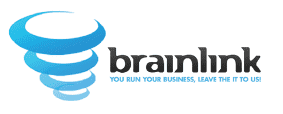
Recently, Brainlink asked a client, “What do you say to IT companies who call/email you to pitch their business?” He replied, “Mostly, I just delete their emails, and tell the really persistent ones no, thank you.” That’s a powerful thing for a client to say, especially one who’s bombarded constantly by other MSPs and specialist IT firms.
Six years ago, retaining business was not so easy. We were losing clients or getting replaced, usually at inconvenient (or stressful) times. So, how did we get to this rare, privileged space where our clients love us, respect us and are actively fending off the poachers?
- We’re constantly educating our existing clients.
99% of Brainlink marketing is NOT aimed at prospects, because we know that we’re not a volume business. We need two to four new clients per year to exceed our revenue, profitability and EBITDA targets. While this business model works for us, it may not necessarily work for you. Go with what you know, but no matter what, invest marketing spend in educating current clients.
- We pursue 100% transparency.
Our clients see 100% of the tickets, project plans, SOPs and configurations. Early on, we have to train them to read the tickets and conduct ticket reviews on and with us. Increasing visibility is just one of many ways to make your IT service delivery more predictable.
- We own up to our mistakes.
We brag when we succeed but are also upfront when we make mistakes. By being honest, and proactively owning up to our shortfalls, we defuse a common source of mutual frustration. However, this does not mean we are a doormat for clients.
- We get clarity on objectives.
If the error lies with the client, we work with the client to resolve those issues. For example, “unclear orders” is a common pain point. While clients may have given us unclear orders, we made a mistake in accepting those orders without getting clarity. This is the number one cause of client dissatisfaction, tech frustration and the biggest issue we tackle daily. Start owning up to your mistakes.
- We embed ourselves in the client culture.
My technicians are at client sites four to five days a week. Even if there are no pending tickets, I proactively send technicians on-site to catch any hidden issues that clients haven’t reported. In doing this, we also learn about changes coming down the pipeline – moves, expansions, hires, terminations, lease renewals, issues with other vendors, etc. If you’re not at a client site every week, you’re leaving $$$ on the table.
- We are VERY picky about who we take on as clients.
A fundamental tenet at Brainlink is that not everyone is qualified to be our client; nor are we qualified to serve everybody. There’s a 10-point checklist every prospect must pass to be considered a real prospect, and ultimately a client. By acquiring and servicing clients who match your company’s Dominance Influence Steadiness Conscientiousness (DISC) profiles, shared cultural values, education levels and mission objectives, you too can transition from “just another IT invoice” to “a trusted vendor.”
- We invest in our vendors and staff.
Yes, like you, we work with several vendors each month. My team is in constant communication with these key companies, and either I or my senior technicians attend their conferences every year. Yes, it’s expensive to go to conferences, and even more expensive to pay for staff to go to conferences (opportunity cost is expensive). However, attending gives us face time with vendor staff and technical support, and helps us foster deeper relationships, faster problem resolution and ultimately, increased client satisfaction.
- We fire customers and keep clients.
Customers are people who pay your bills but have zero loyalty to you, whereas clients are people who seek shelter under your patronage or protection. Every client shows up at Brainlink by choice. It was their choice to seek us as a vendor; it is our active, daily choice to keep them as a client. We routinely ask ourselves, “Is this in the best interest of the client? How can we improve the client’s business and the overall client experience?” Go ahead, look at your Accounts Payable (AP) report. How many customers do you have? How many clients would you energize yourself and your staff to overcome laziness, vendor stupidities and seriously disrupt the status quo for?
- The secret to our success – SOPCulture
Every technical employee at our company is trained on using, updating and creating SOPs – our new technician training manual is over 1800 pages long! Why do we do this? It raises our Operational Maturity Level, and it demonstrates our value to clients. Not only do we share all our SOPs with clients, we also train their staff in developing their internal SOPs. This is how we truly differentiate ourselves from the competition.
We are an SOPCulture thought leader – and you can be too. If you don’t have an SOPCulture in your firm (SOPs, RUNBOOKS, and a documented process for how your business does marketing, service delivery, operations management, etc.), then we should have a conversation. Reach out to {company} at {phone} or {email} today to get started.
